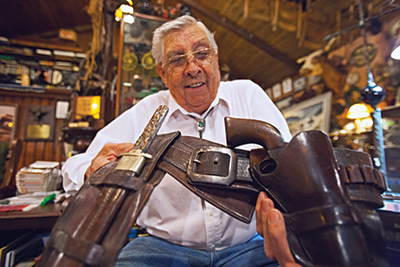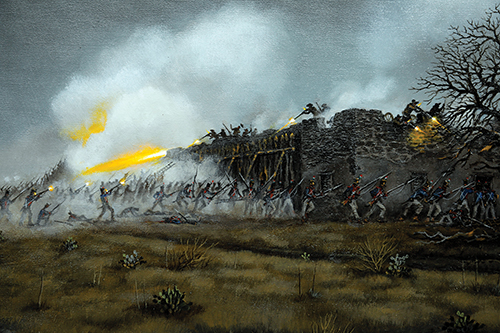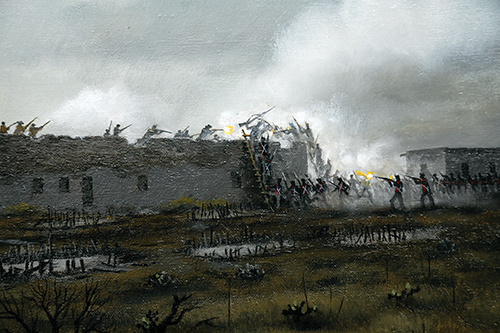
Scores of artists have depicted the Battle of the Alamo, but present-day historians and art patrons agree that none has rendered the legendary clash in San Antonio, Texas, with the historical accuracy Don Yena brings to First Light, Gunsmoke, Bayonets and Texas History, a 36-by-60-inch oil on canvas he completed in 2019. Painted from the attackers’ perspective, it depicts the northwest corner of the compound around dawn on March 6, 1836, just before Mexican forces under General Antonio López de Santa Anna breached the walls and put all of the 200-odd Texian defenders—including William Travis, Jim Bowie and David Crockett—to death.
Yena has rendered larger works, such as The Outfit, a 4-by-6-foot chuck wagon scene displayed in the lobby of the Texas Community Bank in Laredo, as well as some 4-by-8-foot canvases he painted while in the Navy. But he concedes this one consumed his time and thoughts.
“I don’t paint every minute of every day, but I think that painting took about four months,” he says. “But I thought about that painting for about eight years.”
‘It really brought to my mind the size of the compound that so few were trying to defend. It was a lost cause before the first shot was fired’
The project finally got off the ground when Yena met Bruce Winders, longtime historian and curator of Alamo. “I had it between my ears,” the artist explains. “The thing was getting it down on canvas.” A breakthrough came when Winders and staff opened their archives to the artist. “I knew quite a bit [of Alamo history],” Yena says, “but when I got into it with Dr. Winders and his staff, it really brought to my mind the size of the compound that so few were trying to defend. It was a lost cause before the first shot was fired.”
Born in 1933 and raised in Texas from age 3, Yena started drawing as a schoolkid. “I got in trouble in grade school, drawing on stuff instead of learning how to read and write good,” he quips. “My mother had some artistic ability. I saw her sketch a ruin on the place we lived on in Medina County. I saw her sketch that old building, and I was really intrigued. And I still remember her doing that. I could actually sketch that ruin by memory, even though it’s gone.”
After graduating from high school in San Antonio and serving in the Navy, Yena studied under watercolorist Warren Hunter and then worked as an illustrator and freelance artist. Western history has long been his passion.
“I think the actual story of the American West is so fascinating,” he says. “I think it’s more exciting than fiction.”
Which is why so many paintings depicting the Alamo annoy him.

“There were a lot of drawings made of the Alamo at that time, and a lot of them were amateurish, but you can get a lot out of them. But all of those crazy images about Davy Crockett wearing a coonskin cap and swinging “Ol’ Betsy”—that drove me crazy for a long time, because I know what the Alamo church looked like at that time. Or like William Barrett Travis walking on the wall—everything’s on fire all around him, he’s carrying this little pistol, and here comes a dirty, dastardly Mexican, sneaking up on him with a bayonet.
“How does this keep happening?” the artist asks. “And it keeps happening. But some of the worst [paintings] are hanging in our state Capitol. It looks like Red Ryder and Little Beaver did them.”
No one says that about the works of Yena, who enjoys the challenges of doing large oil paintings.

“You have to be so careful with proportions, and I mean inches, with what you’re working on,” he explains. “You do little sketches ahead of time to make sure it’s right, and then you back off across the room and look at it and say, ‘Something’s not quite right here.’ So you go back and, sure enough, you find that your proportions are off, like say a man in proportion to a horse, for instance. Whereas you got something 16-by-20, that makes that problem go away pretty fast.”
Of late Yena has been working on a series of paintings depicting Spanish colonial Texas, and he has no plans of slowing down. “I’ve got good eyes,” he says, “I’m 87 years old and painting much better than I ever have.”
Would he ever attempt another large work on the Alamo?
“Yeah,” he says. “But I’d think about it a hell of a long time.” WW
This article was published in the February 2021 issue of Wild West.





